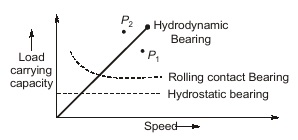Comparison of Rolling and Sliding Contact Bearing
Hydrodynamic Bearing
- Higher starting friction (torque)
- Load carrying capacity vary directly with speed.
- It is suitable for shock, fatigue.
- It is used for high load, high speed application.
• Hydro-static Bearing
- Load carrying capacity is independent of speed.
• Rolling Contact Bearing
- Poor damping capacity.
- Requires low starting torque.
- Under full running capacity, friction loss is more as compared to hydrodynamic bearing.
- Suitable for frequent start/stop applications
- It requires more radial space [but hydrodynamic bearing requires more axial space]
- It is preferred for precise location of journal axis.
Heat Generated in a Bearing
Power Loss Due to Friction is Heat Generated
Ploss = μWV
Here, W = Radial load, V = Rubbing velocity
• Heat Dissipation Equation
Hd = (Δt + 18)2 x A / K watt
Δt = Bearing temperature
A = l × d
K = 0.484 For unventilated bearing
= 0.273 For well-ventilated bearing


